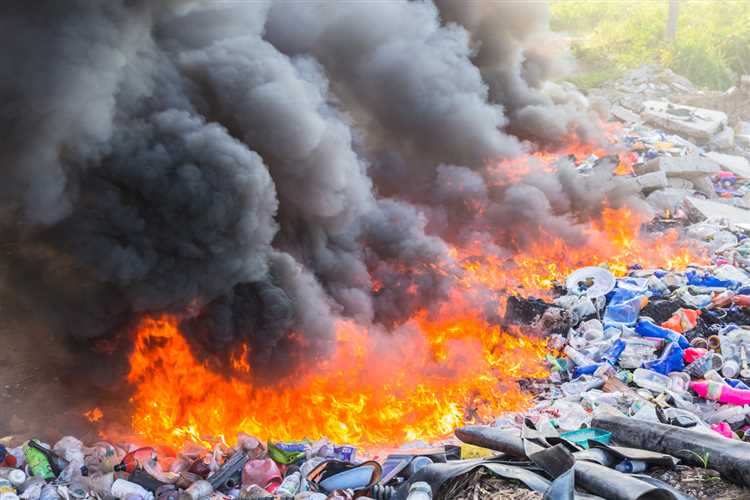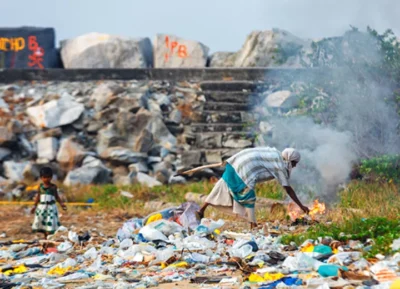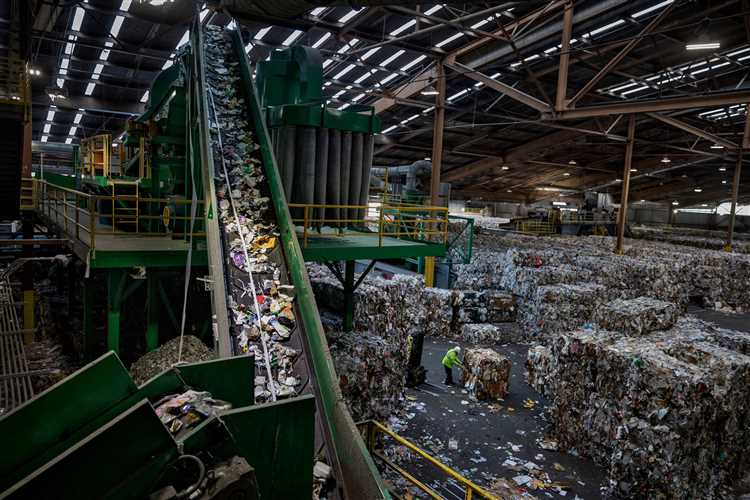
Plastic pollution has become a significant issue in today’s society, affecting the environment and human health. While the ideal solution is to reduce our plastic consumption and find alternative materials, the reality is that plastic waste continues to accumulate. To address this problem, scientists and researchers are exploring eco-friendly ways to burn plastic.
Burning plastic can release toxic gases and contribute to air pollution. However, advancements in technology now make it possible to burn plastic waste while minimizing its harmful effects. By utilizing specially designed incinerators with advanced filtration systems, it is possible to capture and neutralize harmful emissions.
One of the most promising eco-friendly ways to burn plastic is through pyrolysis. Pyrolysis involves heating plastic waste at a high temperature without oxygen, causing it to break down into its constituent elements. This process creates valuable byproducts such as fuel oil and gas, which can be used as alternative energy sources.
Another method being explored is plasma gasification, which involves subjecting plastic waste to high temperatures under a low-oxygen or oxygen-free environment. This process converts the waste into a gas-like substance known as syngas, which can be used to generate electricity or heat. The remaining solid residue can also be used in construction materials.
- Importance of Reducing Pollution
- Eco-Friendly Alternatives for Plastic Combustion
- Benefits of Using Green Technologies
- 1. Environmental Sustainability
- 2. Energy Efficiency
- 3. Job Creation
- Reducing Harmful Emissions
- The Importance of Reducing Harmful Emissions
- Eco-Friendly Methods of Burning Plastic
- Effective Waste Management Solutions
- 1. Recycling
- 2. Composting
- 3. Waste-to-Energy Conversion
- 4. Extended Producer Responsibility (EPR)
- 5. Public Education and Awareness
- The Role of Recycling in Pollution Reduction
- Q&A
- How does burning plastic pollute the environment?
- Are there any eco-friendly ways to burn plastic?
- What is the process of pyrolysis?
- Can pyrolysis be done on a small scale?
- What are the benefits of using pyrolysis to burn plastic waste?
Importance of Reducing Pollution
Reducing pollution is of utmost importance for the wellbeing of our planet and its inhabitants. Pollution, particularly from burning plastic, has a detrimental impact on the environment, wildlife, and human health. It contributes to climate change, destroys ecosystems, and poses serious health risks.
One of the main reasons why reducing pollution is crucial is its effect on climate change. Burning plastic releases harmful greenhouse gases such as carbon dioxide and methane, which trap heat in the atmosphere and contribute to global warming. This leads to rising temperatures, extreme weather events, and the melting of polar ice caps.
Pollution also has a devastating impact on ecosystems. When plastic is burned, toxic pollutants are released into the air, water, and soil, causing harm to plants, animals, and microorganisms. It destroys habitats and disrupts the delicate balance of ecosystems, leading to the extinction of species and the loss of biodiversity.
In addition, pollution from burning plastic poses serious health risks to humans. The toxic chemicals released can enter the respiratory system, causing respiratory problems, allergies, and even cancer. Long-term exposure to these pollutants can have severe and irreversible health effects, particularly for vulnerable populations such as children and the elderly.
By reducing pollution, we can protect the environment, preserve biodiversity, and safeguard human health. Adopting eco-friendly ways to burn plastic, such as using advanced recycling technologies or implementing waste-to-energy systems, can significantly reduce pollution and mitigate its harmful effects. Additionally, investing in alternative energy sources, promoting sustainable practices, and raising awareness about the importance of reducing pollution can all contribute to a cleaner and healthier future for generations to come.
Eco-Friendly Alternatives for Plastic Combustion
While burning plastic can be an effective way to reduce waste and generate energy, it also releases harmful pollutants into the atmosphere. As a more eco-friendly alternative, there are several other methods that can be used to dispose of plastic waste without contributing to pollution.
Recycling: One of the most effective ways to reduce the impact of plastic waste is through recycling. By recycling plastic, the materials can be transformed into new products, reducing the need for virgin plastic production and ultimately decreasing pollution.
Composting: Some types of biodegradable plastics can be composted, which is a natural and environmentally friendly way to dispose of them. Composting breaks down organic materials, including biodegradable plastics, into nutrient-rich soil that can be used to enhance plant growth.
Chemical Recycling: Another eco-friendly alternative is chemical recycling, which involves converting plastic waste into raw materials or petrochemical feedstocks for the production of new plastic. This method allows for the reuse of plastic materials, reducing the demand for new production and minimizing pollution.
Pyrolysis: Pyrolysis is a thermal decomposition process that breaks down plastic waste into useful products such as fuel oil, gas, and char. With careful control of the process, pyrolysis can be a sustainable way to utilize plastic waste and reduce pollution.
| Method | Advantages | Disadvantages |
|---|---|---|
| Recycling | – Reduces the need for virgin plastic production – Decreases pollution |
– Limited recycling infrastructure – Some plastics are difficult to recycle |
| Composting | – Natural and environmentally friendly – Produces nutrient-rich soil |
– Limited to biodegradable plastics – Requires specific composting conditions |
| Chemical Recycling | – Reuses plastic waste – Reduces demand for new plastic |
– Requires advanced technology – Energy-intensive process |
| Pyrolysis | – Converts plastic waste into useful products – Reduces pollution |
– Requires careful process control – Energy-intensive |
These eco-friendly alternatives for plastic combustion provide viable solutions for reducing pollution and minimizing the negative impact of plastic waste on the environment. By adopting these methods, we can work towards a cleaner and more sustainable future.
Benefits of Using Green Technologies
Using green technologies for reducing pollution and addressing environmental issues offers several benefits for both individuals and society as a whole.
1. Environmental Sustainability

One of the main advantages of green technologies is their contribution to environmental sustainability. By utilizing eco-friendly methods and practices, these technologies help to minimize the negative impact on the environment and preserve natural resources for future generations.
For example: Burning plastic in an eco-friendly way can significantly reduce air pollution and the release of harmful toxins into the atmosphere, contributing to cleaner air and a healthier environment.
2. Energy Efficiency
Green technologies are designed to be energy-efficient, meaning they consume less energy than traditional methods while still achieving the desired results. This energy efficiency not only helps to reduce pollution but also lowers energy costs and decreases dependence on non-renewable energy sources.
For example: Using energy-efficient appliances and lighting systems in households helps to conserve energy, reduce greenhouse gas emissions, and save money on electricity bills.
3. Job Creation
The development and implementation of green technologies also contribute to job creation and economic growth. As industries and businesses transition towards more sustainable practices, new job opportunities emerge in sectors such as renewable energy, waste management, and environmental consulting.
For example: By promoting the use of renewable energy sources like solar or wind power, the green technology sector creates jobs in manufacturing, installation, and maintenance of renewable energy systems.
Overall, adopting green technologies offers numerous benefits that extend beyond reducing pollution. They play a crucial role in fostering environmental sustainability, promoting energy efficiency, and driving economic growth. By embracing these technologies, both individuals and society can contribute to a more sustainable and eco-friendly future.
Reducing Harmful Emissions
Reducing harmful emissions is a critical goal for the global community as we strive to protect the environment and human health. One way to achieve this goal is by implementing eco-friendly methods of burning plastic. By adopting these methods, we can minimize the release of toxic gases and pollutants into the atmosphere.
The Importance of Reducing Harmful Emissions
Harmful emissions, such as greenhouse gases and air pollutants, contribute to climate change, respiratory illnesses, and environmental degradation. They also pose a significant threat to the well-being of ecosystems and future generations.
Emissions from traditional plastic incineration have been a major concern due to the release of toxic gases, including dioxins and furans, which are known to be highly carcinogenic and harmful to humans and wildlife.
Eco-Friendly Methods of Burning Plastic
To reduce harmful emissions while burning plastic, several eco-friendly methods can be employed:
- Pyrolysis: Pyrolysis involves heating plastic waste in the absence of oxygen, which breaks it down into usable fuels like gas and oil while minimizing harmful emissions. This process also reduces the volume of waste generated.
- Gasification: Gasification is a process that converts plastic waste into a synthesis gas, which can be used for energy production. It provides a cleaner and more efficient alternative to traditional incineration.
- Plasma Gasification: Plasma gasification uses a high-temperature plasma arc to convert plastic waste into a gas state. This method is highly efficient in reducing emissions and producing clean energy.
These eco-friendly methods not only reduce harmful emissions but also offer opportunities for energy recovery and resource conservation. By adopting these techniques, we can pave the way for a more sustainable and ecologically responsible approach to plastic waste management.
Effective Waste Management Solutions

Proper waste management is crucial in reducing pollution and preserving the environment. Here are some effective waste management solutions that can help in dealing with the plastic waste problem:
1. Recycling
Recycling is one of the most effective ways to manage plastic waste. It involves the process of collecting, sorting, and processing plastic materials to produce new products. By recycling plastic, we can reduce the amount of waste that ends up in landfills or incinerators.
2. Composting
Composting is a natural process that decomposes organic waste, including food scraps and yard trimmings, into nutrient-rich compost. By composting biodegradable materials, we can divert them from landfills and reduce methane emissions.
3. Waste-to-Energy Conversion
Waste-to-energy conversion technologies convert non-recyclable waste materials, including plastic, into usable forms of energy. This process helps reduce the volume of waste in landfills while generating electricity or heat.
4. Extended Producer Responsibility (EPR)
Extended Producer Responsibility is a policy approach that holds manufacturers accountable for the entire lifecycle of their products, including their disposal. By implementing EPR programs, manufacturers are incentivized to design products that are easier to recycle and implement proper waste management practices.
5. Public Education and Awareness
Educating the public about the importance of proper waste management and the harmful effects of plastic pollution can significantly contribute to reducing pollution. Increasing awareness can encourage individuals to adopt responsible waste disposal habits, support recycling programs, and actively participate in efforts to minimize plastic waste.
Implementing these waste management solutions will not only help reduce pollution but also contribute to the conservation of natural resources and the overall well-being of the planet.
The Role of Recycling in Pollution Reduction
Recycling plays a crucial role in reducing pollution and promoting a sustainable future. By recycling materials like plastic, paper, glass, and metal, we can significantly decrease the amount of waste that ends up in landfills or pollutes our environment.
One of the main benefits of recycling is the conservation of natural resources. By reusing materials, we can lessen the need for raw materials extraction, which often involves environmentally damaging processes like mining or logging. This conservation effort helps protect natural habitats and preserves biodiversity.
Moreover, recycling helps in reducing the pollution caused by the production and disposal of goods. Manufacturing products from recycled materials requires less energy and water compared to using virgin materials. It also generates fewer greenhouse gas emissions and air pollutants, helping to mitigate climate change and improve air quality.
Recycling plastics, in particular, is vital for pollution reduction. Plastic waste is a major environmental problem due to its slow decomposition rate and harmful effects on wildlife and ecosystems. By recycling plastic, we can prevent it from ending up in oceans and landfills, where it can contaminate water sources and harm marine life. Recycling plastic also conserves energy, as producing new plastic requires a significant amount of fossil fuel extraction and processing.
Implementing an effective recycling system requires participation from individuals, businesses, and governments. Education and awareness campaigns can help promote responsible recycling practices and encourage citizens to properly dispose of recyclable materials. Governments can also play a crucial role by implementing policies and regulations that prioritize recycling and support the development of recycling infrastructure.
In conclusion, recycling is a key component of pollution reduction efforts. By recycling materials, we can conserve natural resources, reduce pollution from production and disposal, and prevent plastic waste from polluting our environment. It is vital that we all embrace recycling as a sustainable and eco-friendly practice, working together to create a cleaner and healthier planet for future generations.
Q&A
How does burning plastic pollute the environment?
Burning plastic releases toxic chemicals and pollutants into the air, which can contribute to air pollution and have negative effects on human health.
Are there any eco-friendly ways to burn plastic?
Yes, there are. One method is known as pyrolysis, which involves heating the plastic in the absence of oxygen to break it down into useful chemicals and fuels.
What is the process of pyrolysis?
Pyrolysis is a thermal decomposition process that breaks down the plastic into its molecular components by heating it in the absence of oxygen. The resulting byproducts can then be used to generate energy or as feedstock for the production of other materials.
Can pyrolysis be done on a small scale?
Yes, pyrolysis can be done on a small scale. There are small-scale pyrolysis machines available that can be used to process plastic waste and convert it into useful products.
What are the benefits of using pyrolysis to burn plastic waste?
Using pyrolysis to burn plastic waste has several benefits. It can help reduce the amount of plastic waste that ends up in landfills or oceans, it can generate useful products and energy, and it can be a more eco-friendly alternative to traditional methods of plastic disposal.